What Is Street Photography?
May 6, 2015 by Marie Joabar
Researching an article on Street Photography I came across this article by Eric Kim. It’s an enjoyable read and brings up some interesting points about the topic.
Since Eric shares this as “Open Source” and encourages sharing as a way to educate, I decided to share it with you and hope you find his take on the matter insightful.
Note, some editing was done for length of article considerations.
What is Street Photography?
August 7, 2013 By Eric Kim
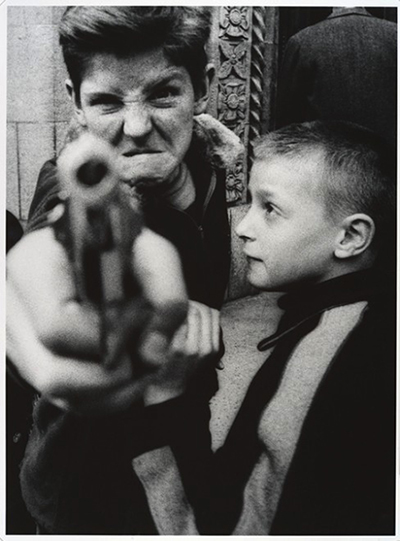 There are countless forum threads, Facebook discussions, blogs, and Flickr boards which argue what street photography is and what street photography isn’t. I have thought about the question: “What is street photography?” for a long time– and my thoughts and views have changed and evolved over the years.
There are countless forum threads, Facebook discussions, blogs, and Flickr boards which argue what street photography is and what street photography isn’t. I have thought about the question: “What is street photography?” for a long time– and my thoughts and views have changed and evolved over the years.
I don’t have all the answers to defining what street photography is (or isn’t) but I will attempt to come to some sort of logical conclusion on what street photography means to me. Consider this article as part of a self-reflective essay for me to better understand my own personal views. And I also hope that you can take some of my thoughts and incorporate it into your own personal views– and reach your own conclusions for yourself.
What street photography isn’t
1. Landscape photography
If I see a photo of a tree, water, and a sunset– I don’t consider it street photography. Why not? I would not consider landscape photography street photography as nature is the primary subject. Therefore I feel there needs to be an “urban” element that ties into street photography.
2. Studio photography
I would also not consider studio photography street photography. The nature of studio photography is to have everything staged and preconceived, and a bit on the artificial side. Consider the model, makeup, hair, background, how it is shot indoors– all in control of the photographer, makeup artist, lighting assistant, etc. Therefore I feel that street photography needs an element of spontaneity and uncertainty rather than the predictable/manipulative nature of studio photography.
To transition, I will write out some certain misconceptions I feel exist when it comes to street photography:
Candid or Posed
I think this is the most controversial point I will bring up in this article. I personally don’t think that street photography has to be candid. I think that the best street photographs are the candid ones– but I don’t think that it needs to be a necessary element. For example, consider the following street photographs that weren’t photographed candidly:
The photograph above (Kid with gun © William Klein) is one of William Klein’s most iconic photographs– the kid with the gun pointing his gun straight at the photographer, with a menacing look full of anger. The photo looks candid enough– but the contact print that William Klein shares shows that in the next frame, the kids are laughing and completely aware of the photographer.
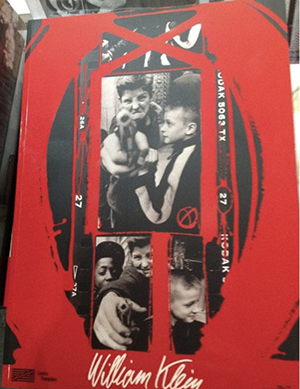
Not only that, but William Klein has shared that when he saw the kids playing with the toy guns, he yelled to one kid, “Look tough” which prompted the kid to turn around and point his gun straight at Klein.
William Klein has been challenged on his approach of “provoking” his subjects. After all, how can the photo be “genuine” if he is simply telling his subjects what to do? Klein responded by saying that although it was he who provoked his subjects to play up a certain reaction or expression– it was his subjects who ultimately reacted the way they did.
For example, when he told the kid to “look tough”– the kid could have interpreted that a hundred different ways. He could have simply stood with the gun by his side, pointed the gun at the air, etc. However– he decided to point the gun straight at Klein with a sinister look. This is possibly a reaction that Klein even himself couldn’t have expected.
Also when looking at the photograph itself– it doesn’t look staged or posed. It looks authentic.Therefore I feel that for myself personally, I care less if a photograph is staged or not– but whether it elicits some sort of reaction in my gut and heart. Who cares if a street photograph is posed or candid– if it doesn’t stir something in my soul?
Another photograph that was photographed with permission and cooperation from the subject is Diane Arbus’ famous “Kid with grenade” photo in Central Park. (Kid with grenade Copyright: The Estate of Diane Arbus) This is once again, another photograph I would classify as a quintessential “street photograph.”

If you look at the contact sheet of the photographs Arbus took of the kid, you see that she took many photos of him– in different poses and arrangements.
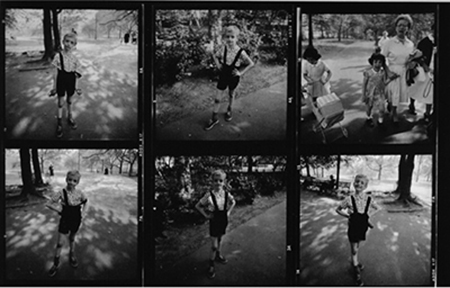
Obviously the most stirring and bizarre photo she took was the first frame, with the kid clutching the grenade in one of his hands– with his other hand curled up like he was about to die. The look in his face looks like a mix between confusion, fear, and anxiety. To top it off, he even has a shoulder strap falling off his shoulder– which adds to this feeling of uneasiness.
Some street photographers I know say that street photographs have to be candid and shot without permission from the subject. But would these street photographers say that this photograph isn’t a street photograph?
Many of Arbus’ photos were taken in public of people she didn’t know– many of them with implicit or explicit permission from her subjects. Almost all street photographers I know would certainly classify her as one of the great “street photographers” in history.
So as a personal conclusion to myself– I have concluded that street photography doesn’t have to be candid. But still having a “candid look” makes a photo feel more authentic and interesting. Even the photo Arbus took of the kid with the grenade– I feel that the expression of the kid is something she couldn’t have ever dreamed of. Rather, it was the kid who was the willing participant who put on some sort of strange show for Arbus.
Public vs private places
As of now, my personal belief is that street photography can really be shot anywhere as long as it is open to the public to enter and leave as they please. Photo below © Bruce Davidson from his Subway book. 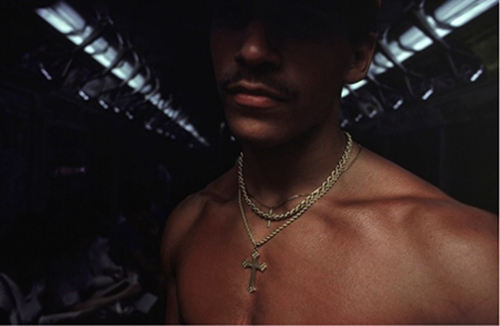 I think it can be done in a hotel or office lobby, in a subway, an office building, a shopping center, on the beach (Bruce Gilden and Martin Parr have done great work there). Just about anywhere in public where people can enter an area without needing permission.
I think it can be done in a hotel or office lobby, in a subway, an office building, a shopping center, on the beach (Bruce Gilden and Martin Parr have done great work there). Just about anywhere in public where people can enter an area without needing permission.
Definitions, shmefinitions
What I hate about definitions is that they are often controlled by academics, historians, and people with some sort of authority. But who gives them the power to name and classify everything as they please? After all, many street photographers were classified as street photographers (against their own will).
Garry Winogrand, the quintessential street photographer of our times who hated the term “street photography” just considered himself a “photographer.” Bruce Davidson also did the majority of his work in the streets and is often called a ‘street photographer’. But Davidson as well– despised the term “street photography” and refused to call himself that. Above all, Henri Cartier-Bresson (which all purists believe to be the real grandfather of street photography) never called himself a “street photographer” or the work that he did as “street photography.”
What is really important?
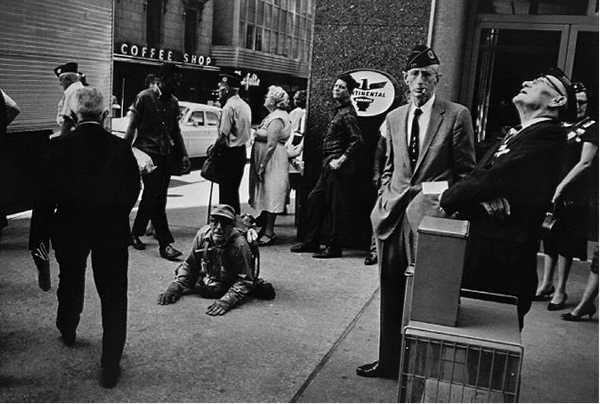 One of my favorite photos by Garry Winogrand– which shows a strong social message (the veterans ignoring this seemingly disabled veteran). What does this say about our society? So I feel that in this sense, I recommend giving the middle finger to definitions– and not worrying about it. Who cares what people classify your type of photography to be? As long as you enjoy the photos you are taking– isn’t that enough?
One of my favorite photos by Garry Winogrand– which shows a strong social message (the veterans ignoring this seemingly disabled veteran). What does this say about our society? So I feel that in this sense, I recommend giving the middle finger to definitions– and not worrying about it. Who cares what people classify your type of photography to be? As long as you enjoy the photos you are taking– isn’t that enough?
Rather than worrying about if your photo is a bona-fide “street photograph” or not– let’s focus on making memorable photographs. Photographs that stir us emotionally, that make us think about humanity, society around us, the people we interact on a daily basis, the small beauties of life that we pass up for granted, others who are suffering, and the hopes and dreams of everyday individuals.
I feel as a final concluding point, I want us to have a broader view of street photography– rather than contracting what it is or isn’t. I think that one of the beauties of street photography is its democratic and open nature– that anyone can participate in it regardless of where they live, what camera they shoot with, or the subjects they decide to photograph.
Street photography - A clumsy diagram of some different branches of the “school of street photography”
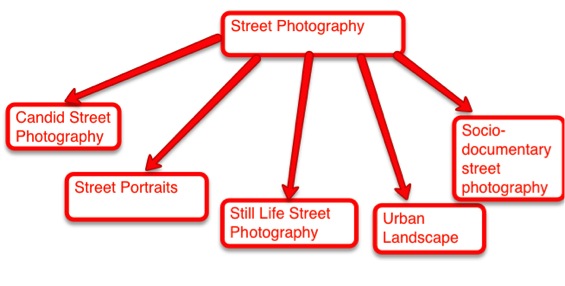
I think in street photography there are now lots of sub-gernres as well. I feel that we have candid street photography (what I might classify as “classic street photography”- think Henri Cartier-Bresson), street portraits (focused mostly on portraits of people on the street, instead of the environment– either with or without permission like Diane Arbus or Bruce Gilden), urban landscapes with or without people in them (think Stephen Shore, Lee Friedlander, Joel Sternfeld, etc), still life street photography (think Martin Parr or William Eggleston), or socio-documentary street photography (think Bruce Davidson).
Let’s all get along
One of my favorite photos by HCB (© Henri Cartier-Bresson / Magnum Photos) – love the joy and happiness he captured here. 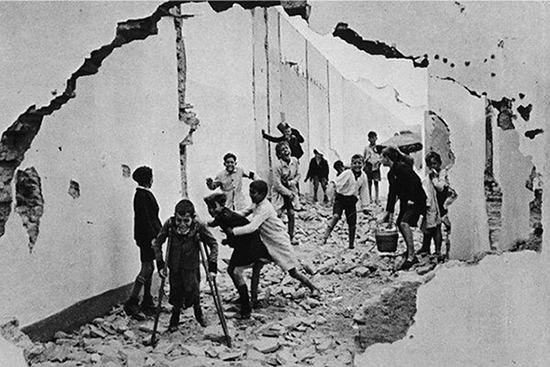
So once again– let’s not worry about definitions about what street photography is or isn’t. What is important that we are all drawn to photographing humanity and society around us– rather than just pretty sunsets and flowers.
We all have different reasons why we photograph– whether it be for historical, personal, or socio-economic reasons. Some of us want our photos to affect people on an emotional level and have others reconsider their lives, some of us shoot for ourselves for the challenge and to release stress from our everyday existence, and some of us want our photos to be a record of our society to show our future grandchildren.
So rather than arguing whether my photo is “street photography,” or whether your photo is “street photography”– let’s collaborate and not argue. Let’s aim to make beautiful art and document the human condition together.
♥ Eric Kim
To see the unedited article from Eric, CLICK HERE
